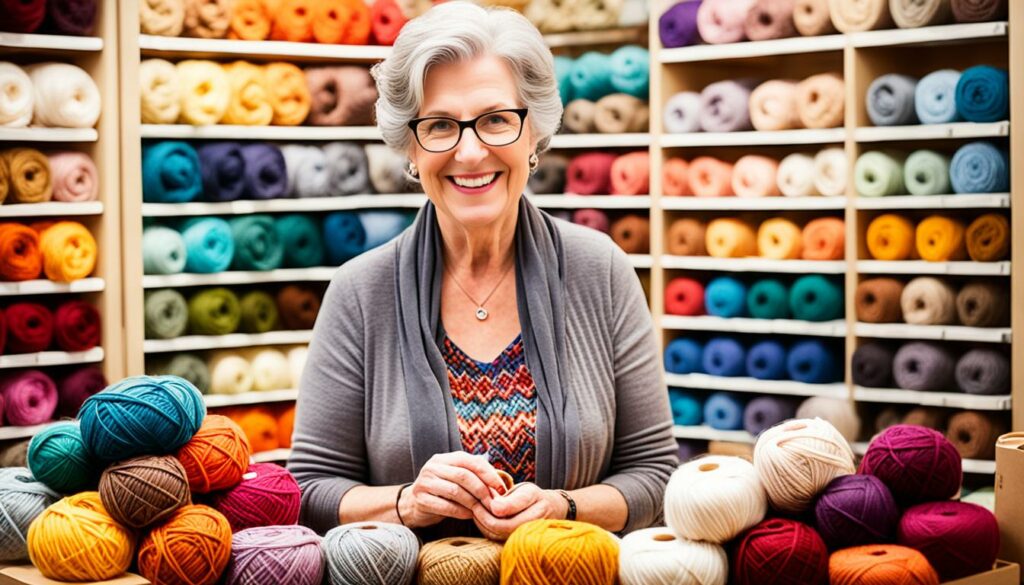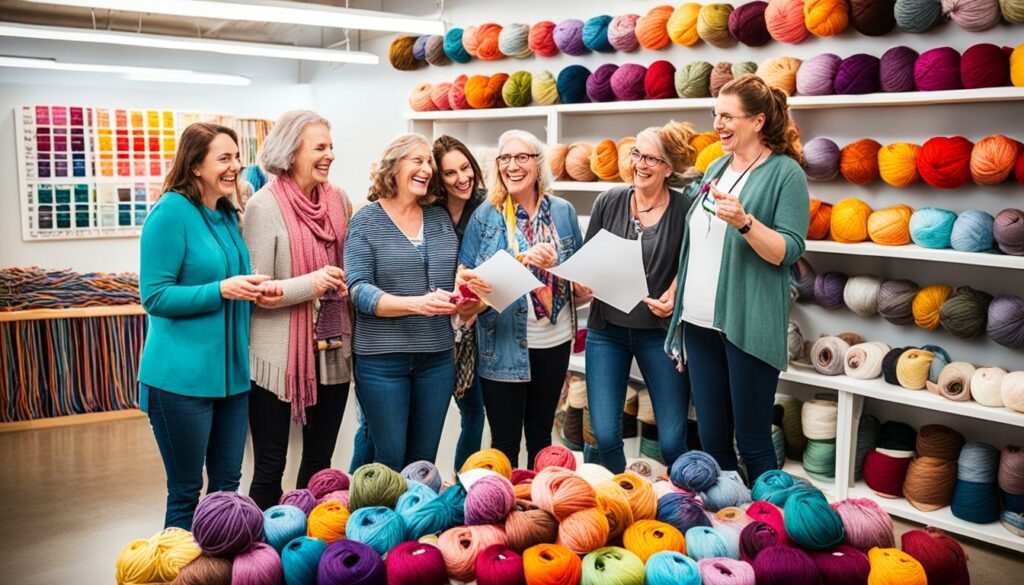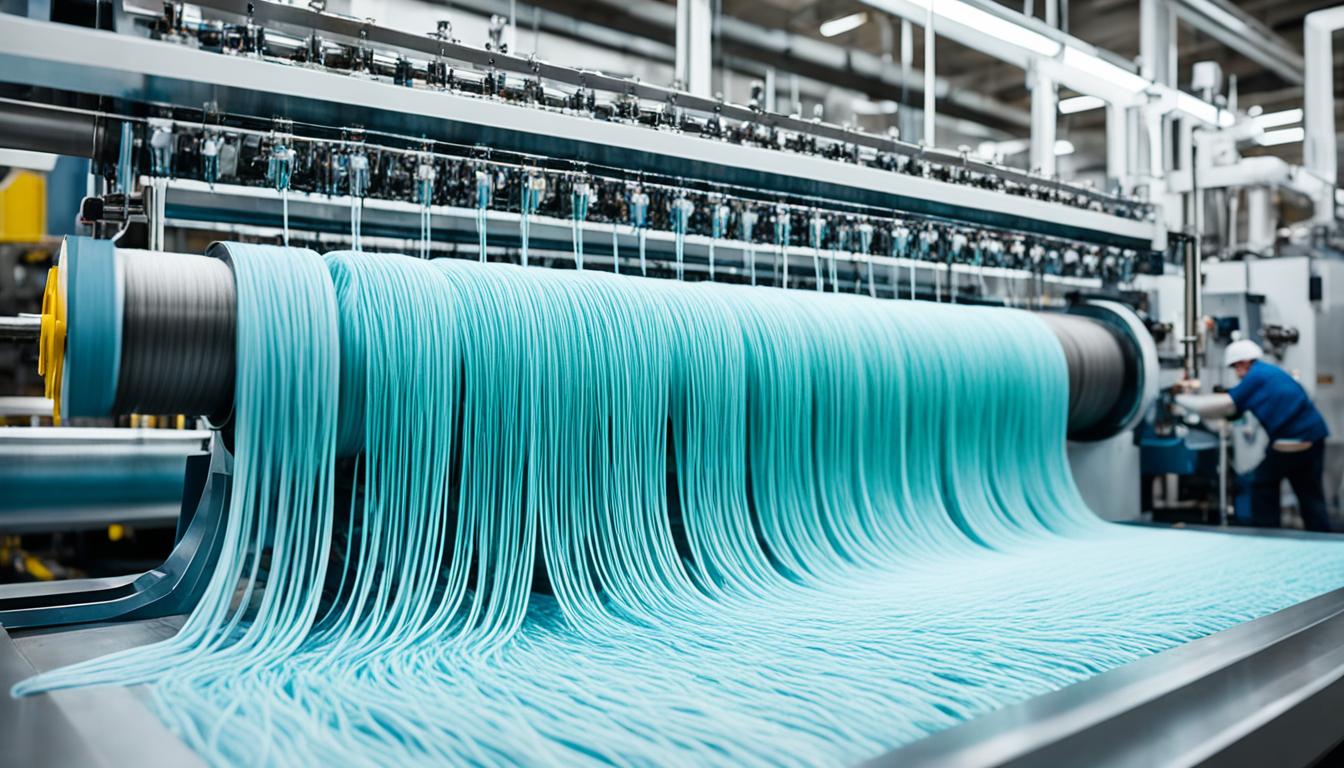Will you continue to work at The Yarn Barn? Are you wondering about the current job status and work situation at our beloved store? We understand that there may be questions about employment status and job stability at The Yarn Barn, and we are here to give you the details you seek.
Key Takeaways:
- Find out the latest updates and plans for working at The Yarn Barn.
- Discover the current employment status and job continuity at our store.
- Get clarity on the work situation and find out if you will still be working at The Yarn Barn.
- Explore the future plans of The Yarn Barn and what they mean for employees.
- Stay informed and up to date on the job updates and employment at The Yarn Barn.
Supplies Available for Beginners
At The Yarn Barn, we understand the excitement and anticipation of starting a new crafting journey. That’s why we offer a wide selection of beginner supplies to help you get started on your creative endeavors. Our goal is to provide everything you need to dive into the world of yarn crafting with confidence and enthusiasm.
Essential Crafting Tools
When it comes to crafting, having the right tools makes all the difference. Our range of supplies includes:
- Crochet hooks
- Knitting needles
- Stitch markers
- Darning needles
- Scissors
These tools are essential for crochet and knitting projects, helping you create beautiful stitches and intricate designs with ease. Whether you’re a beginner or an experienced crafter, having high-quality tools is key to achieving exceptional results.
A Rainbow of Yarns
No crafting journey is complete without a plethora of yarn options. Our yarn selection is carefully curated to offer a variety of colors, textures, and weights to suit every project. From soft and cozy acrylic yarns to luxurious natural fibers like merino wool, we have something for everyone. Our knowledgeable staff is always available to help you find the perfect yarn for your next masterpiece.
Additional Crafting Notions
In addition to hooks, needles, and yarns, we also carry various other crafting notions to enhance your projects. Our selection includes:
- Looms and circles for weaving
- Beads for embellishments
- Hair ties for handmade accessories
- Miscellaneous notions to support your creativity
These tools and accessories add versatility and personalization to your crafting endeavors, allowing you to explore new techniques and create unique designs.
“The right tools and supplies can make all the difference in your crafting journey. At The Yarn Barn, we strive to provide a comprehensive range of beginner-friendly supplies to help you unleash your creativity and achieve stunning results.” – The Yarn Barn Team
| Supplies | Description |
|---|---|
| Crochet Hooks | Ergonomic hooks in various sizes for comfortable crocheting |
| Knitting Needles | Smooth needles in different materials and lengths for knitting projects |
| Stitch Markers | Colorful markers to help track stitches and pattern repeats |
| Darning Needles | Yarn needles with blunt tips for weaving in ends and seaming |
| Scissors | Sharp and compact scissors for cutting yarn and thread |
Whether you’re a complete beginner or looking to expand your craft collection, you can find all the necessary supplies at The Yarn Barn. Visit our store today and embark on a creative journey filled with endless possibilities!
Yarn at the Barn Events
Are you passionate about fiber arts and eager to share your expertise with others? We are excited to announce that Yarn at the Barn will be hosting a series of events, and we are actively searching for presenters and demonstrators who can showcase their skills and inspire the community.
Our events are the perfect platform to connect with like-minded individuals and foster a supportive and creative environment for everyone. Whether you specialize in knitting, crochet, weaving, or any other fiber craft, we would love to hear from you.
To become a presenter or demonstrator at our Yarn at the Barn events, please reach out to our friendly Event Coordinator, Jamie M LaCour. Jamie has been instrumental in organizing and curating our events, and she would be thrilled to hear from you.
You can contact Jamie via email at Morwen31@gmail.com or give her a call at (816) 896-0034. She will be happy to provide more information about the event opportunities and answer any questions you may have.
Don’t miss this chance to share your passion and connect with fellow fiber enthusiasts. Join us at Yarn at the Barn events, and let’s inspire and celebrate the joy of creating together!
| Event Details | Presenter Contact Information |
|---|---|
| Date | Your preferred availability |
| Time | Your preferred time slot |
| Location | The Yarn Barn |
| Theme | Your area of expertise or preferred topic |
| Presenter Requirements |
|
Yarn Shop Owner
Owning a yarn shop is a dream for many in the industry. As a yarn shop owner, we have the opportunity to curate shelves filled with beautiful yarns, work with designers and dyers, and foster a knitting community. It is a role that requires a strong knowledge of the craft and the ability to interact with customers in a warm and inviting manner.
One of the key responsibilities of a yarn shop owner is to build a sense of community. By organizing events, workshops, and knit-a-longs, we can create a space where crafters can gather, share their passion for knitting and crochet, and learn from each other. Building a strong community will not only attract customers but also create a supportive network that fosters creativity and collaboration.
Having knowledge of various crafts is also essential as a yarn shop owner. Customers will come to us with a wide range of questions and requests, from stitch patterns to yarn substitutions. Being able to provide guidance and advice on different techniques and projects will establish us as a trusted resource in the community.
However, it is important to acknowledge that owning a yarn shop comes with its challenges. Financial considerations are a crucial aspect to consider. From inventory management to rent and utilities, there are various costs to be accounted for. It is crucial to carefully plan and budget to ensure the financial stability of the shop.
Another challenge is establishing a strong social media presence. In today’s digital age, having an online presence is vital for reaching a wider audience and staying connected with customers. Creating engaging content, managing online platforms, and staying updated with current trends are all part of maintaining a successful social media strategy.

Yarn Shop Employee
Working as a yarn shop employee is an incredibly fulfilling role for those with a passion for crafting. At our yarn shop, we understand the joy and creativity that comes from working with yarn, and we strive to create a welcoming and supportive environment for all crafters.
While prior retail experience can be beneficial, what truly makes a great yarn shop employee is a genuine love for crafting. Our team is comprised of individuals who are passionate about different fiber arts and are eager to share their knowledge and expertise with our customers.
As a yarn shop employee, you’ll have the opportunity to help crafters of all skill levels. Whether it’s assisting a beginner knitter in selecting their first set of needles or helping an experienced crocheter find the perfect yarn for their next project, your expertise and guidance will make a difference.
In addition to providing customer service, yarn shop employees may have various other responsibilities. You may have the chance to teach classes and workshops, sharing your skills and helping others develop their craft. You may also be involved in managing social media accounts, creating captivating content to engage with our community online.
It’s important to note that most yarn shop positions are part-time, which offers flexibility but also has its challenges. The pay for yarn shop employees can vary depending on factors such as location and experience.
“Working at the yarn shop has been a dream come true for me. I get to spend my days surrounded by beautiful fibers and inspiring crafts, and I get to help others pursue their creative passions. It doesn’t feel like work when you’re doing something you love!”
If you have a passion for crafting and enjoy working in a retail environment, a job as a yarn shop employee may be the perfect fit for you. Join us in creating a space where crafters can find inspiration, guidance, and support on their creative journey.
Yarn Shop Employee Responsibilities
As a yarn shop employee, you may be responsible for:
- Assisting customers in selecting yarn and supplies
- Providing guidance and instruction to crafters of all skill levels
- Teaching classes and workshops
- Managing social media accounts
- Stocking and organizing inventory
Challenges of Being a Yarn Shop Employee
While working in a yarn shop is incredibly rewarding, it does come with its unique challenges. Some of these challenges include:
- Managing the diverse needs and requests of customers
- Keeping up with trends in the crafting industry
- Maintaining a balance between the creative and business aspects of the job
- Working with a part-time schedule and potential fluctuations in hours
Comparison of Yarn Shop Employee Positions and Pay
| Position | Average Pay |
|---|---|
| Entry-level Yarn Shop Employee | $10 – $15 per hour |
| Experienced Yarn Shop Employee | $12 – $20 per hour |
| Lead Yarn Shop Employee (Supervisory Role) | $15 – $25 per hour |
Table: A comparison of yarn shop employee positions and their average pay rates. Please note that these figures are approximate and can vary based on factors such as location and years of experience.

Yarn Dyer
Becoming a yarn dyer is an exciting journey for those with an artistic inclination and a passion for color. As a yarn dyer, you have the opportunity to transform plain yarn into a vibrant palette of hues, creating unique and eye-catching fibers for crafters to enjoy.
Dyeing yarn is a process that requires a mastery of color and an understanding of how different shades interact with one another. It involves experimenting with various dye colors to develop new combinations and achieve desired outcomes. Through practice and perseverance, you can refine your skills and develop a deep understanding of color theory.
Building a Business
Being a yarn dyer is not just about artistic expression; it also involves managing a business. To succeed in this industry, you need to be business-savvy and develop solid strategies for branding, marketing, and customer acquisition. Competition in the yarn dyeing market is fierce, so it’s essential to find ways to stand out from the crowd and attract customers.
One of the challenges of being a yarn dyer is finding the right balance between creativity and profitability. While it’s fulfilling to create beautiful yarns, you also need to ensure that your business is financially sustainable. This requires carefully managing expenses, pricing your products competitively, and making strategic decisions that drive growth.
Challenges and Rewards
Like any career, being a yarn dyer comes with its own set of challenges. The dyeing process can be time-consuming, requiring attention to detail and meticulous planning. You may also face logistical challenges, such as sourcing high-quality yarn bases and managing inventory.
However, the rewards of being a yarn dyer are numerous. You have the opportunity to unleash your creativity, express your artistic vision, and share your passion with fellow crafters. Seeing your yarns bring joy to others and being part of the vibrant yarn community can be incredibly fulfilling.
Pay and Starting Resources
The pay for yarn dyers varies widely based on the success of their business. Some dyers are able to establish thriving enterprises and earn a substantial income, while others may start as a side gig or passion project that gradually grows over time. It’s important to have realistic expectations and understand that building a successful dyeing business takes time and effort.
If you’re considering a career as a yarn dyer, there are many resources available to help you get started. Online tutorials on dye techniques and color theory can provide valuable knowledge and guidance. Additionally, networking with other dyers and attending industry events can offer insights and opportunities to learn from seasoned professionals.
| Challenges of Being a Yarn Dyer | Starting Resources for Aspiring Dyers |
|---|---|
| Intense competition in the market | Online tutorials on dye techniques |
| Managing a profitable business | Color theory resources |
| Logistical challenges in sourcing yarn bases | Networking with other dyers |
Developing your skills as a yarn dyer and building a successful business can be a fulfilling journey. It requires a combination of artistic talent, color mastery, and business acumen. With dedication and persistence, you can turn your passion for dyeing yarn into a rewarding career.

Yarn Dyer’s Support Team
Working as part of a yarn dyer’s support team allows you to be intricately involved in the yarn industry, even if you’re not the expert. Our support positions provide a range of opportunities to contribute to the success of the dye house and brand.
Assisting in the Dye House
As part of the support team, you’ll have the chance to work in the dye house, assisting with various aspects of the dyeing process. This can include preparing dye lots, monitoring color consistency, and ensuring the quality of each dyed skein.
Wholesale Order Processing
Support positions also involve processing wholesale orders. You will play a vital role in fulfilling orders from retailers by accurately picking and packing the desired products. Your attention to detail and efficiency will be crucial in maintaining customer satisfaction.
Customer Service
Customer service is a key aspect of our support positions. You’ll have the opportunity to interact directly with customers, providing information about our products, addressing inquiries or concerns, and ensuring a positive experience for every customer.
Marketing
Support team members may also be involved in marketing efforts. This can include managing social media accounts, creating engaging content, and participating in promotional campaigns. Your creativity and understanding of the yarn industry will contribute to the growth of our brand.
Working in a yarn dyer’s support team presents its own set of challenges and rewards. You’ll need to be adaptable and versatile, as tasks can vary based on the needs of the business. However, being part of a supportive and collaborative team makes these challenges easier to navigate.
We value the contributions of our support team members and strive to offer fair compensation. Support positions are typically paid on an hourly basis, with rates starting at $12 per hour. We believe in acknowledging the important role each team member plays in our collective success.

Join our yarn dyer’s support team and become an integral part of the yarn industry. Embrace the exciting challenges, contribute to the growth of our brand, and help us create beautiful and vibrant yarns for crafters worldwide.
Conclusion
At The Yarn Barn, we believe that the yarn industry offers a plethora of exciting career opportunities for individuals with a passion for yarn. Whether you dream of owning your own yarn shop, expressing your creativity as a yarn dyer, or contributing to a dyer’s support team, there is a place for you in this vibrant industry.
Each career path in the yarn industry comes with its own unique set of challenges and rewards. From the responsibilities of a yarn shop owner, including interacting with customers and building a community, to the artistic challenges faced by yarn dyers in creating stunning colorways, there is a role to suit every individual.
Whether you’re considering a career change or looking to pursue your lifelong love for yarn, the yarn industry offers countless job opportunities waiting to be explored. So, why not embark on a fulfilling journey by pursuing a career in the yarn industry? With dedication, hard work, and a genuine passion for yarn, you can turn your dream into a reality. Welcome to the world of diverse yarn industry careers!










